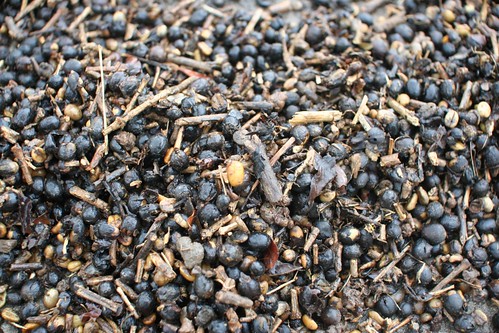After 11 days in Brazil I have had a total of 7 hours of rest (not counting sleeping at night), taken 7 airplanes, spent at least 30 hours in a car, cupped at least 150 different coffees and visited around 20 farms all across Brazil. I have also done 3 intensive days of coffee seminars, barista and roast- training for about 30 people in Sao Paulo at Isabela Raposeiras’s coffee lab and at the Uni Octavio.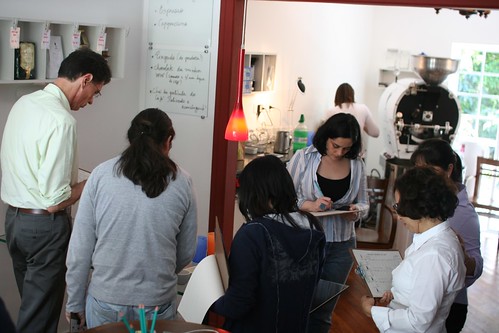
The trip has been very exciting and extremely educational, and although I have been to Brazil a couple of times in the past, I have never been in Brazil as a coffee buyer. Traveling with a coffee buyers point of wiev really opened my eyes in terms of what Brazil has to offer.
I came to brazil with no expectations of the qualities I would find here, as most of the coffees I have tasted from Brazil has been quite neutral in flavour, hevy bodied, sweet, chocolaty and low on acidity. (I think this is what most people expect a Brazilian coffee to taste like.) Therefore I had a very open mind in terms of what kind of flavour profiles I was looking for. Little did I know that Brazil could offer such a vast difference in qualities. I found coffees that were like a classic Brazil, very sweet, low acidity, chocolate and nutty aromas and creamy mouthfeel. This is what I look for to use in our espresso blend. Especially because of the sweetness and lingering sweet aftertaste, these coffees are like the potato, you can use them for everything.
I also found crazy coffees. Especially one from Piata that tasted like liquid molasses (the syrup gained from sugar cane). Another coffee I found in Mococa tasted like a washed Ethiopian Yirgacheffe with high citric acidity, coffee flowers and bergamoth in the aromas and delicate slim body. Unfortunately, this coffee was allready sold, but the molasses coffee will probably be in our shelves this winter.
Our competitor and coffee friends at KAFFA had also bought a lot from Piata that I really liked. Very transparent, fruity and elegant coffee. I am glad it will be available in Norway, as this was a great coffee too. (If they had not bought it, I would.)
I think one of the main reasons why Brazilian coffees has a reputation of being a bit dull and can only be used for espresso blending is that Brazil is the biggest coffee producing country in the world with a lot of mechanical harvesting and a very streamlined production where most of the farmers have been doing more or less the same things to their coffee for years and years. Their coffees used to be sold in bulk, and because everything is mixed and sold together, you get very uniform coffees and loose the unique coffees. Although a lot of the coffees still have “the Brazilian profile” there is a lot of farmers experimenting with different varietals, growing practices, picking practices, processing techniques, resting, etc. Sometimes with great results, other times disasterous.
Here are some different practices that I found on my travels through Brazil:
Growing:
Conventional, streamlined growing including tonns of fertilizer, pesticides, irrigation systems, pruning of the trees, mechanical harvesting or strip picking. These are medium to large scale producers producing both very mediocre coffees and some good coffees. Big monoculture plantations with a few trees around functioning as wind breakers.
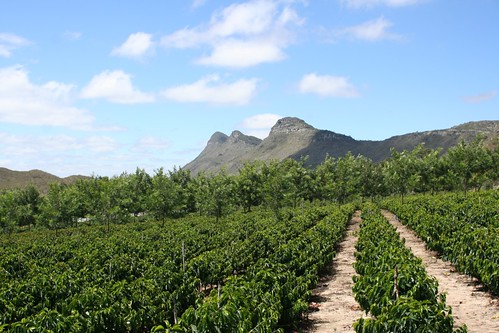
Organic, not necessarily certified organic growing, but the farmers use no pesticides and only use organic fertilizers. Farms look a bit different from the larger ones, but are still streamlined and most picking is done by hand, either strip picking (everything is ripped off the branch) or selective picking. Coffee trees are normally grown under some shade trees like banana palms, Gravelia, Mango trees, etc.
Biodynamical / forest coffee, Coffee grown in a secondary forest. The trees are not pruned, nor are they treated with any fertilizer or pesticides. Picking is done by hand selectively or by strip picking.
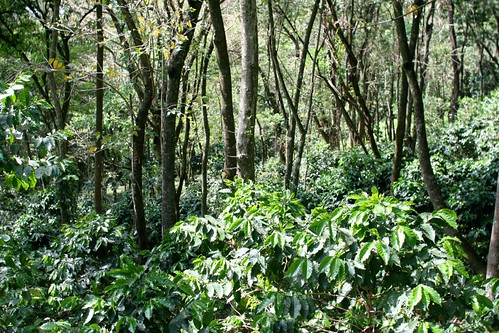
Althoug I only tasted some organic and forest coffees, they were by far very different from the majority of the conventional grown coffee. They had a lot of acidity and floral aromas. The best coffee I tried came from a farmer that had just decided to stop using fertilizer and pesticides and let mother nature do her work. The coffee trees adapted over a 2 year period and the production was now only slightly lower than normal, trees were even more healthy, the farm looked more natural and the farmer was very happy because his production cost was lower and his coffee tasted far better. He was now investing money in suspended beds for drying his coffee as this had given him the best results so far. (Below is a picture of The farmer Mr. Hamilton on his beautiful farm.)
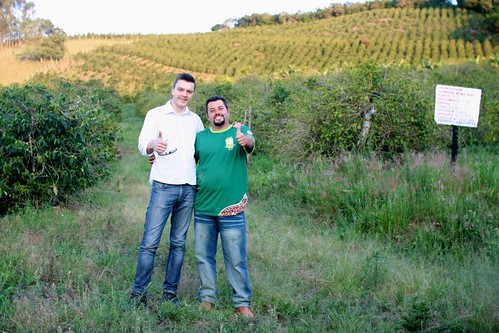 :
:
Processing:
Natural processing of coffee is the most common way of drying the coffee after harvesting. This is the traditional way of drying coffee and because it is less labour intensive and therefore cheaper it is normally used on the worst qualities in all countries around the world. It is difficult to get a clean result in the cup by natural processing the coffee, however Brazil has a reputaton of preparing great natural processed coffees that are sweet and these coffees are often used in espresso blends to enhance the sweetness. If done properly, a natural processed coffee can taste fantastic, but in most cases there are a lot of unripe coffee among the ripe coffee which makes the cup taste astringent, nutty and dry.
The most common practice is to strip pick the coffee from the tree when 80% of the coffee cherries has dried out to become what farmers call raisins. (Since the coffee trees are fully exposed to the sun and the climate is dry, the cherries dry on the tree and look like raisins.) Still there are some fully ripe, unripe and semi ripe cherries on the tree, but everything is picked and separated mechanically before drying. (In most cases the separation process is not working 100%)
Below is a picture of the left over coffee from the 2009 harvest. This coffee is picked up from the ground and stripped from the trees in order to prevent diseases and insect damage to the trees and to prepare for the next harvest. This coffee is rarely exported and is sold to coffee roasters in Brazil for local consumption
I really think that this type of coffee should be banned from the market, as it is full of toxins and really is unhealthy to drink. Brazil is today one of the biggest consumers of coffee in the world, but unfortunately the coffee drunk in Brazil is nothing close to the qualities that they export. If the big quantities of poor quality coffee was removed from the market I believe the market price for coffee would go up to a sustainable level and both the farmers and the consumers would benefit. Yes we can!
Pulped natural is when the coffee cherries are picked when they are fully ripe (or sometimes strip picked), the skin and pulp of the coffee cherry is removed from the beans mechanicaly by squeesing the cherries and the beans are dried on suspended beds or patios with the sticky mucilage left on. This often creates a cleaner coffee than the natural processed coffee but still with a lot of sweetness.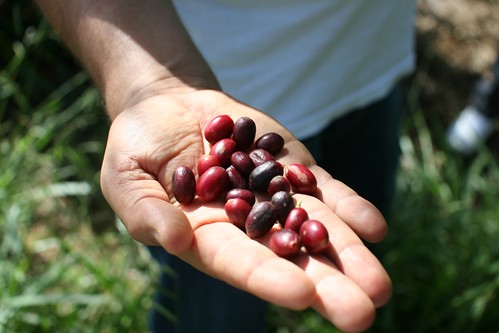
Semi washed is when the beens are depulped and sent through a mechanical demucilage machine that normally uses water and centrifugal principles in order to remove the desired amount of mucilage from the beans before drying. This creates more acidity in the cup and normally also a cleaner cup.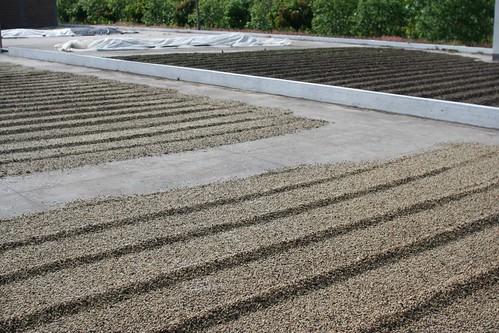
Fully washed can sometimes be the same as semi washed, but all the mucilage is removed with the demucilage machine. In some cases fermentation tanks are used after the demucilage machine where the beans will soak in water from around 6 to 24 hours before they are dried. The beans are rarely washed after fermentation, as most of the mucilage is removed in the demucilage machine anyway.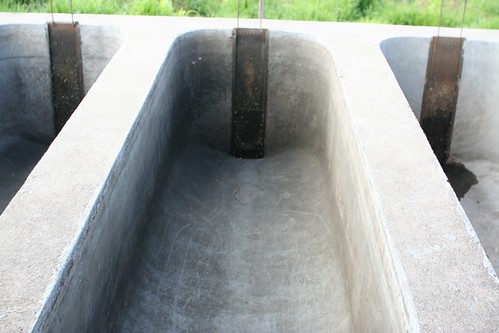
Repass is used occationally as an experimental method. Normally the dried raisins (natural coffees) are re- soaked in water until the pulp is moist again. Then the cherries are depulped and dried as a pulped natural coffee. Unfortunately I did not get to taste this version.
These are only some of the differences I found in Brazil, and there are no absolute truths wether strip picking is better than selective picking or natural process is better than fully washed, etc. The fact is that a well produced coffee will taste better than a poorly produced coffee regardless of production method. That means a well prepared natural processed coffee will always taste better than if the farmer is washing his coffee but doing it without care and attention. I know this is very basic knowledge, but still we come across discussions where people say that natural processed coffee is inferior to washed, and that strip picked coffee is equivalent to poor quality.
I think we should encourage the diversity of production methods and let our taste decide what we like or not.
After all, we drink coffee because of it’s flavour, not the story…
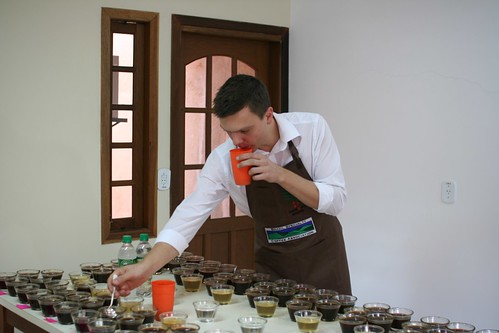
There are more pictures from my trip to Brazil here.

